《跨文化交际语篇分析法》共57页文档
- 格式:ppt
- 大小:4.91 MB
- 文档页数:57


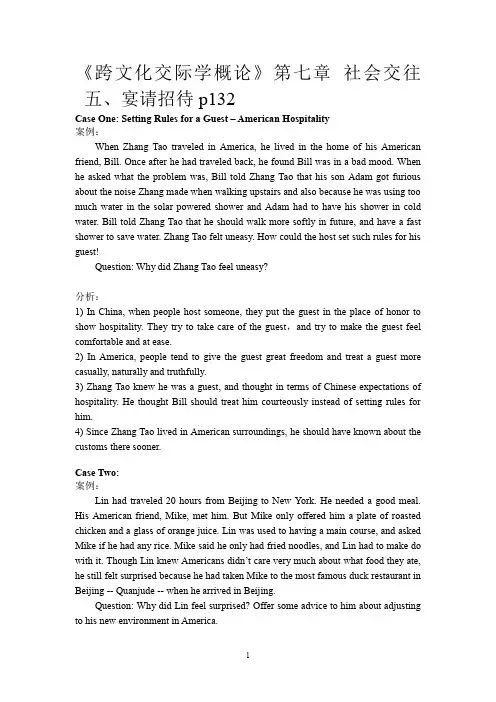
《跨文化交际学概论》第七章社会交往五、宴请招待p132Case One: Setting Rules for a Guest – American Hospitality案例:When Zhang Tao traveled in America, he lived in the home of his American friend, Bill. Once after he had traveled back, he found Bill was in a bad mood. When he asked what the problem was, Bill told Zhang Tao that his son Adam got furious about the noise Zhang made when walking upstairs and also because he was using too much water in the solar powered shower and Adam had to have his shower in cold water. Bill told Zhang Tao that he should walk more softly in future, and have a fast shower to save water. Zhang Tao felt uneasy. How could the host set such rules for his guest!Question: Why did Zhang Tao feel uneasy?分析:1) In China, when people host someone, they put the guest in the place of honor to show hospitality. They try to take care of the guest,and try to make the guest feel comfortable and at ease.2) In America, people tend to give the guest great freedom and treat a guest more casually, naturally and truthfully.3) Zhang Tao knew he was a guest, and thought in terms of Chinese expectations of hospitality. He thought Bill should treat him courteously instead of setting rules for him.4) Since Zhang Tao lived in American surroundings, he should have known about the customs there sooner.Case Two:案例:Lin had traveled 20 hours from Beijing to New York. He needed a good meal. His American friend, Mike, met him. But Mike only offered him a plate of roasted chicken and a glass of orange juice. Lin was used to having a main course, and asked Mike if he had any rice. Mike said he only had fried noodles, and Lin had to make do with it. Though Lin knew Americans didn’t care very much about what food they ate, he still felt surprised because he had taken Mike to the most famous duck restaurant in Beijing -- Quanjude -- when he arrived in Beijing.Question: Why did Lin feel surprised? Offer some advice to him about adjusting to his new environment in America.分析:1) 0n the topic of hospitality, the Chinese stress on warmth and demonstrating friendship. They take the guest to a famous or luxurious restaurant to have a very good (expensive) meal to show their hospitality. And the Chinese are used to having a big meal. The more dishes they put out,the greater the warmth and friendship they show.2) In western countries, people stress on freedom. They give the guest great freedom to choose their own foods. And westerners tend to have only one main course and some juice or dessert,which is viewed as casual in the eyes of the Chinese.3) Lin lived in American surroundings and should have adjusted himself quickly to the new world (lifestyle). He should have known the custom there first, and felt more at ease in Mike’s h ome.Case Three: Equality or Hospitality for Table Manners案例:Lin Hua has accompanied an American delegation to visit China. They have experienced the hospitality of the Chinese people. After returning to America, Linhua once visited them. They were so glad to meet again. Linhua offered to host the meal, but they refused. They ordered their own dish, and Linhua ordered her own. When footing the bill, they only paid their part,and no one wanted to pay for Linhua. Linhua found them so inhospitable, though she knew the Americans would usually pay for their own food.Question: Why did Linhua find them inhospitable?分析:1) In China, to show hospitality, people tend to host the meal. And if they cannot do this, they at least will struggle to pay for the guest.2) In America, people tend to pay for themselves to show equality and independence.3) Linhua knows this custom, but from a Chinese point of view, she still finds this hard to accept, and feels it a little inhospitable.Case Four:案例:I have an American friend. I have invited him several times, and at long last he invited me to his home one day. He told me to get there at 3 p m. I thought we could chat and have a meal together. I gave him a Chinese calendar, a woman’s scarf and a bottle of Chinese white wine. He only took out a dish of nuts, a plate of bread and a bottle of wine. After two hours’ chat, I found there was no hint of a meal and said good-bye to him. He only gave me a box of chocolate as a present for the New Year. After I got home, I found the box already been opened. I was very surprised, Question: What surprised me?分析:1) In China, a visit to home always includes a meal. And the guest always bringsa relatively expensive present to the host. And the present should be well wrapped or untouched.2) In the west, a visit to home only means a meeting, not necessarily including a meal. And the present is treated not as importantly as it is in China.3) I acted in a way that was based on Chinese customs, so I felt the American way was very interesting (unusual).Case Five: Way of Entertaining Guests in China ---- Drink more and more案例:Tom, an American, went to a Chinese home for the first time. He was offered some tea. Just when the first cup was about to finish, more tea was added. He drank the second cup. Then the cup was filled the third time. Then he drank it, then ⋯ until he was quite full. Tom was totally confused by the way of entertaining.Question: Why was Tom totally confused?分析:1) Traditional Chinese custom requires that during the course of entertaining, the host has to always pour more wine or tea to the guest’s glass or cup, and always adds more food to the guest’s plate or bowl without asking whether it’s wanted.2) Chinese guests know how to respond to this type of hospitality. They simply leave the wine, tea, or food in the container and stop having any more. But Tom, the American guest in the case didn’t know this.3) He followed the politeness rule of his culture: it’s not good manners to leave food in one’s own plate at a dinner table. Therefore, without any knowledge of the differences between the two cultures, an American guest would very likely suffer from either drinking or eating too much in such a situation.Case SixAs a foreign student at the University of Wisconsin in Madison, Keiko Ihara (Japanese) was on a strict budget. She had all her tuition and books paid for by scholarships and grants and until recently was comfortably housed in the dormitory. Wanting to live in the community rather than in the dormitory, she found a small apartment to share with a friend. Her college friends, knowing of her situation, offered to round up some of the necessary items for apartment living. Keiko politely declined, saying she could manage. Wanting to help out her friends found some old but still usable household appliances and furniture. Mary had an old desk that was in hergarage. Ed had some chairs from his uncle, and Joe and Marion had a few extra dishes. They cheerfully brought them over one day. Keiko seemed very embarrassed, but gracefully accepted them, sincerely and profusely thanked them.The following week they were each presented with a gift from Keiko. Mary got an ornate jewelry box, Ed a volume of woodcuts by a famous Japanese artist, and Joe and Marion a beautiful Japanese vase, all of which were of considerable worth and value, much more than the old things they had donated to her. They all protested that she could not afford to give such elaborate gifts; they really expected nothing as the household items were not really being used and they would rather have her use them. Keiko, however, insisted that they take the gifts. In the end, they accepted the gifts, although they all felt uncomfortable as they knew she was really sacrificing to give them.Questions:1. What do you think of Keiko insisting on giving valuable gifts to her college friends?2. Why did Keiko’s friends feel very uncomfortable when they received valuablegifts in return?分析:Keiko insists on giving valuable gifts to her college friends, because in countries like Japan, exchanging gifts is a strongly rooted social tradition. Should you receive a gift, and don’t have one to offer in return, you will probably create a crisis. If not as serious as a crisis, one who doesn’t offer a gift in return may be considered rude or impolite. Therefore, in Japan, gifts are a symbolic way to show appreciation, respect, gratitude and further relationship.Keiko obviously has taken those used items from Mary, Ed and Marion as gifts, for she probably doesn’t know that Americans frequently donate their used household items to church or to the community. Mary, Ed and Marion would never consider those used household items given to Keiko as gifts. No wonder they felt very uncomfortable when they received valuable gifts in return.Case SevenSelma, who is from the US, is in a student exchange program in Indonesia. One day, she was asked to attend a birthday party and she was delighted, for she was curious to know what an Indonesian birthday party was like. To her surprise, she was the only one that dressed in typically Western clothes. Although she had no strong reason to become uneasy, her uneasy feeling prevailed as the party was going on. To make herself feel better, she went to the food table and began to help herself. But, upon leaving the table, she tripped on the leg of a chair and spilled her drink on the floor. One of the girls stooped down to mop up the spill and everyone else laughed out loud. Selma, uncertain what to do next, quietly moved out of her way with her head lowered in shame.Questions:3. What functions does laughing serve in similar situations in China?4. What should we do to help ourselves or other people out of embarrassmentcaused by cultural differences in laughing?分析:Just like smile, laughing does not always serve the same function in different cultures. Interestingly, for us Chinese, laughing often has a special function on some tense social occasions. People may laugh to release the tension or embarrassment, to express their concern about you, their intention to put you at ease or to help you come out of the embarrassment. In this case, the people there were actually wishing to laugh with the American rather than laugh at her. Their laughing seemed to convey a number of messages: don‘t take it so seriously; laugh it off, it‘s nothing; such things can happen to any of us, etc. Unfortunately the American was unaware of this. She thought they were laughing at her, which made her feel more badly and angry, for in her culture laughing on such an occasion would be interpreted as an insulting response, humiliating and negative.。
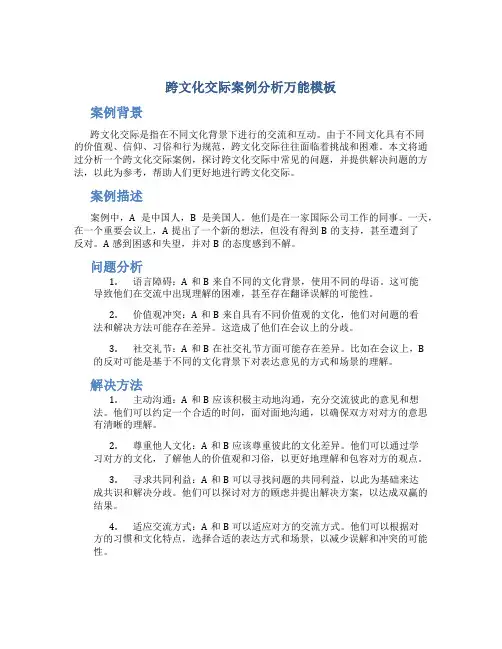
跨文化交际案例分析万能模板案例背景跨文化交际是指在不同文化背景下进行的交流和互动。
由于不同文化具有不同的价值观、信仰、习俗和行为规范,跨文化交际往往面临着挑战和困难。
本文将通过分析一个跨文化交际案例,探讨跨文化交际中常见的问题,并提供解决问题的方法,以此为参考,帮助人们更好地进行跨文化交际。
案例描述案例中,A是中国人,B是美国人。
他们是在一家国际公司工作的同事。
一天,在一个重要会议上,A提出了一个新的想法,但没有得到B的支持,甚至遭到了反对。
A感到困惑和失望,并对B的态度感到不解。
问题分析1.语言障碍:A和B来自不同的文化背景,使用不同的母语。
这可能导致他们在交流中出现理解的困难,甚至存在翻译误解的可能性。
2.价值观冲突:A和B来自具有不同价值观的文化,他们对问题的看法和解决方法可能存在差异。
这造成了他们在会议上的分歧。
3.社交礼节:A和B在社交礼节方面可能存在差异。
比如在会议上,B的反对可能是基于不同的文化背景下对表达意见的方式和场景的理解。
解决方法1.主动沟通:A和B应该积极主动地沟通,充分交流彼此的意见和想法。
他们可以约定一个合适的时间,面对面地沟通,以确保双方对对方的意思有清晰的理解。
2.尊重他人文化:A和B应该尊重彼此的文化差异。
他们可以通过学习对方的文化,了解他人的价值观和习俗,以更好地理解和包容对方的观点。
3.寻求共同利益:A和B可以寻找问题的共同利益,以此为基础来达成共识和解决分歧。
他们可以探讨对方的顾虑并提出解决方案,以达成双赢的结果。
4.适应交流方式:A和B可以适应对方的交流方式。
他们可以根据对方的习惯和文化特点,选择合适的表达方式和场景,以减少误解和冲突的可能性。
结论跨文化交际虽然存在挑战和困难,但通过主动沟通、尊重他人文化、寻求共同利益和适应交流方式等方式,我们可以更好地解决问题,建立跨文化交际的良好关系。
希望通过这个万能模板,能帮助更多人在跨文化交际中更加成功和顺利。
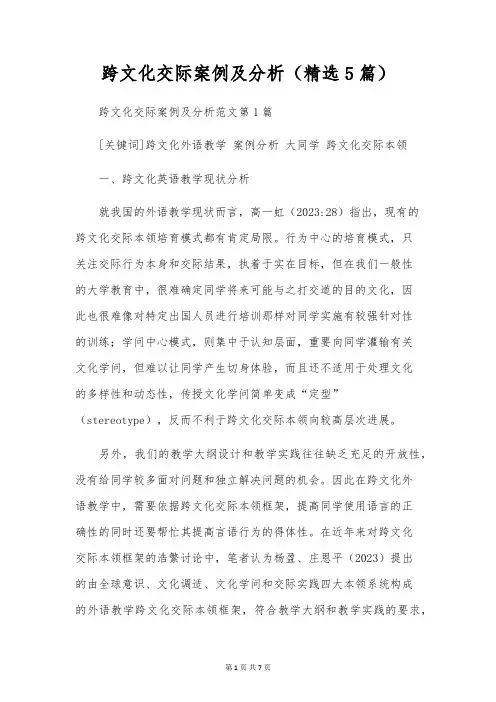
跨文化交际案例及分析(精选5篇)跨文化交际案例及分析范文第1篇[关键词]跨文化外语教学案例分析大同学跨文化交际本领一、跨文化英语教学现状分析就我国的外语教学现状而言,高一虹(2023:28)指出,现有的跨文化交际本领培育模式都有肯定局限。
行为中心的培育模式,只关注交际行为本身和交际结果,执着于实在目标,但在我们一般性的大学教育中,很难确定同学将来可能与之打交道的目的文化,因此也很难像对特定出国人员进行培训那样对同学实施有较强针对性的训练;学问中心模式,则集中于认知层面,重要向同学灌输有关文化学问,但难以让同学产生切身体验,而且还不适用于处理文化的多样性和动态性,传授文化学问简单变成“定型”(stereotype),反而不利于跨文化交际本领向较高层次进展。
另外,我们的教学大纲设计和教学实践往往缺乏充足的开放性,没有给同学较多面对问题和独立解决问题的机会。
因此在跨文化外语教学中,需要依据跨文化交际本领框架,提高同学使用语言的正确性的同时还要帮忙其提高言语行为的得体性。
在近年来对跨文化交际本领框架的浩繁讨论中,笔者认为杨盈、庄恩平(2023)提出的由全球意识、文化调适、文化学问和交际实践四大本领系统构成的外语教学跨文化交际本领框架,符合教学大纲和教学实践的要求,具较强可行性。
二、案例分析在跨文化英语教学中的作用目前跨文化英语教学普遍采纳的方法重要包括背景学问导入、文化内涵探究、案例分析、角色扮演及情景仿照、实例搜索等。
案例分析教学中将不同文化背景的语言特色、风土人情、历史事件和现实冲突等素材呈现于同学面前,是跨文化学问、意识、思维和交际本领的综合训练过程,能帮忙同学达到学习外语语言技能与培育跨文化交际本领有机结合的目的。
在谈到案例教学法时,陈建平(2023)强调:“案例是为适应特定的教学目的而编写的”,教学过程重要是“同学之间的讨论和辩论”,教学目的重要是“培育同学的本领”。
上述特点,使案例教学能很好适用于跨文化外语教学,它对培育本领的重视大过取得学问,成为语言文化学问向跨文化本领变化的有效途径。
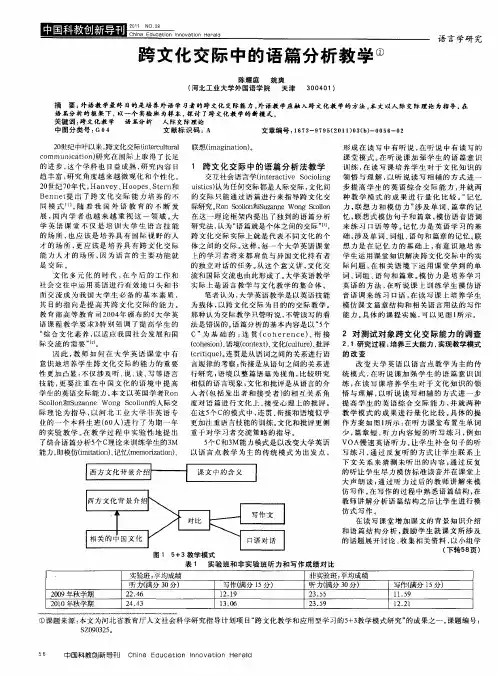
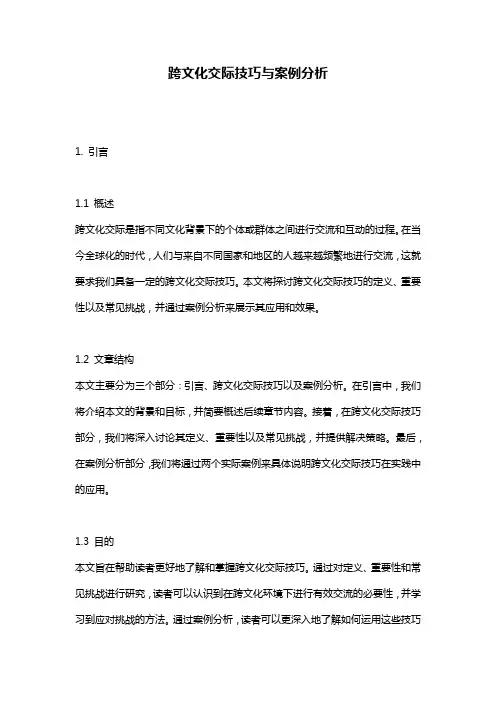
跨文化交际技巧与案例分析1. 引言1.1 概述跨文化交际是指不同文化背景下的个体或群体之间进行交流和互动的过程。
在当今全球化的时代,人们与来自不同国家和地区的人越来越频繁地进行交流,这就要求我们具备一定的跨文化交际技巧。
本文将探讨跨文化交际技巧的定义、重要性以及常见挑战,并通过案例分析来展示其应用和效果。
1.2 文章结构本文主要分为三个部分:引言、跨文化交际技巧以及案例分析。
在引言中,我们将介绍本文的背景和目标,并简要概述后续章节内容。
接着,在跨文化交际技巧部分,我们将深入讨论其定义、重要性以及常见挑战,并提供解决策略。
最后,在案例分析部分,我们将通过两个实际案例来具体说明跨文化交际技巧在实践中的应用。
1.3 目的本文旨在帮助读者更好地了解和掌握跨文化交际技巧。
通过对定义、重要性和常见挑战进行研究,读者可以认识到在跨文化环境下进行有效交流的必要性,并学习到应对挑战的方法。
通过案例分析,读者可以更深入地了解如何运用这些技巧解决实际问题,在跨文化交际中取得良好的效果。
最终,本文还将提出一些建议和策略,以帮助读者在实际生活和工作中更好地应用跨文化交际技巧。
2. 跨文化交际技巧:2.1 定义与背景:跨文化交际技巧是指在不同文化背景下进行有效沟通和互动的能力。
随着全球化进程的推进,不同文化之间的交流变得非常频繁,因此掌握跨文化交际技巧对于个人和组织来说变得尤为重要。
在跨文化交际中,人们往往会面临来自不同国家、地区或群体的人们所持有的各种价值观、信仰体系、社会规范以及语言表达方式等方面的差异。
这些差异可能导致误解、冲突甚至失败。
因此,了解并掌握跨文化交际技巧对于建立有效沟通和相互理解至关重要。
2.2 重要性与作用:跨文化交际技巧具有以下重要性和作用:首先,跨文化交际技巧有助于建立信任和友好关系。
通过了解对方的文化背景、价值观和行为习惯,我们可以更好地适应并尊重对方,在交流过程中体现出善意和尊重。
其次,掌握跨文化交际技巧有助于解决跨文化交际中的挑战。



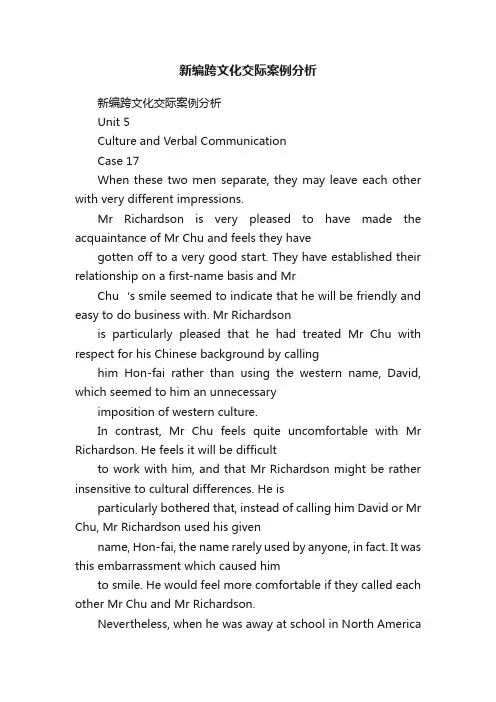
新编跨文化交际案例分析新编跨文化交际案例分析Unit 5Culture and Verbal CommunicationCase 17When these two men separate, they may leave each other with very different impressions.Mr Richardson is very pleased to have made the acquaintance of Mr Chu and feels they havegotten off to a very good start. They have established their relationship on a first-name basis and MrChu‘s smile seemed to indicate that he will be friendly and easy to do business with. Mr Richardsonis particularly pleased that he had treated Mr Chu with respect for his Chinese background by callinghim Hon-fai rather than using the western name, David, which seemed to him an unnecessaryimposition of western culture.In contrast, Mr Chu feels quite uncomfortable with Mr Richardson. He feels it will be difficultto work with him, and that Mr Richardson might be rather insensitive to cultural differences. He isparticularly bothered that, instead of calling him David or Mr Chu, Mr Richardson used his givenname, Hon-fai, the name rarely used by anyone, in fact. It was this embarrassment which caused himto smile. He would feel more comfortable if they called each other Mr Chu and Mr Richardson.Nevertheless, when he was away at school in North Americahe learned that Americans feeluncomfortable calling people Mr for any extended period of time. His solution was to adopt awestern name. He chose David for use in such situations.Case 18Even if the American knew Urdu, the language spoken in Pakistan, he would also have tounderstand the culture of communication in that country to respond appropriately. In this case, hehad to say ―No at least three times.In some countries, for instance, the Ukraine, it may happen that a guest is pressed as many asseven or eight times to take more food, whereas in the UK it would be unusual to do so more thantwice. For a Ukrainian, to do it the British way would suggest the person is not actually generous.Indeed, British recipients of such hospitality sometimes feel that their host is behaving impolitelyby forcing them into a bind, since they run out of polite refusal strategies long before the Ukrainianhost has exhausted his/her repertoire of polite insistence strategies.Case 19Talking about what‘s wro ng is not easy for people in any culture, but people in high-contextcountries like China put high priority on keeping harmony, preventing anyone from losing face, andnurturing the relationship. It seems that Ron Kelly had to learn a different way of sending messagewhen he was in China. At home in Canada he would havegone directly to the point. But in China,going directly to the problem with someone may suggest that he or she has failed to live up to his orher responsibility and the honor of his or her organization is in question. In high-context cultures likeChina, such a message is serious and damaging. In low-context cultures, however, the tendency isjust to ―spit it out, to get it into words and worry about the result later. Senders of unwelcomemessages use objective facts, assuming, as with persuasion, that facts are neutral, instrumental, andimpersonal. Indirectness is often the way members of high-context cultures choose to communicateabout a problem.Case 20It seems that the letters of request written in English as well as in Chinese by Chinese peopleare likely to preface the request with extended face-work. To Chinese people, the normal andpolite way to form a request requires providing reasons that are usually placed before the requests.Of course, this is just the inverse of English conventions in which requests are fronted withoutmuch face-work. In the view of the English-speaking people, the opening lines of Chinese requests and some other speech acts do not usually provide a thesis or topic statement which will orient the listener to the overall direction of the communication. Worst of all, the lack of precisionand the failure to address the point directly may lead to suspicions that the Chinese speakers arebeating around the bush. To them, the presence of a clear and concise statement of what is to betalked about will make the speech more precise, more dramatic, and more eloquent.However, the Chinese learning and using English in communication may find it difficult tocome to terms with the common English tendency to begin with a topic statement. In the Chinese culture, stating one‘s request or main point at the beginning would make the person seemimmodest, pushy, and inconsiderate for wanting things. If yourspeech gives others the impressionthat you are demanding something, you would lose face for acting aggressively and notconsidering the others. Thus you‘d be hurting people by claiming something for yourself.In such a situation, it is usually considered a smart strategy if you carefully delineate the justifications that will naturally lead to your request or argument. Therefore, instead of stating their proposition somewhere in the beginning and then proceeding to build their case, Chinesepeople often first establish a shared context with which to judgetheir requests or arguments. Onlyafter carefully prefacing them with an avalanche of relevant details, as if to nullify any opposition,will they present the requests or arguments.Unit 6Culture and Nonverbal CommunicationCase 21Sometimes our best intentions can lead to breakdowns in cross-cultural communication. For example, one of the very common manners of touching --- handshaking --- may result in conflict when performed with no consideration of cultural differences. Among middle-class North American men, it is customary to shake hands as a gesture of friendship. When wanting to communicate extra friendliness, a male in the United States may, while shaking hands, grasp with his left hand his friend‘s right arm. However,to people of Middle Eastern countries, the left hand is profane and touching someone with it is highly offensive. Therefore,in Vernon‘s eyes, Kenneth was actually an extremely offensive messageto him.Case 22In Puerto Rican culture, as in some other Latin American and Eastern cultures, it is not right for a child to keep an eye-contact with an adult who is accusing him or her, while in the United States, failing of meeting other person‘s eye accusing him or her would be taken as a sign of guiltiness. As the principal knew little about this culturaldifference in using eye-contact, he decided that the girl must be guilty. Generally speaking, avoiding eye-contact with the other(s) is often considered as an insult in some cultures, but may signify respect for authority and obedience in other cultures.Case 23Just like smile, laughing does not always serve the same function in different cultures. Interestingly, for us Chinese,laughing often has aspecial function on some tense social occasions. People may laugh to release the tension or embarrassment, to express their concern about you, their intention to put you at ease or to help you come out of the embarrassment. In this case, the people there were actually wishing to laugh with the American rather than laugh at her. Their laughing seemed to convey a number of messages: don‘t take it so seriously; laugh it off, it‘s nothing; such things can happen to any of us, etc. Unfortunately the American was unaware of this. She thought they were laughing at her, which made her feel more badly and angry, for in her culture laughing on such an occasion would be interpreted as an insulting response, humiliating and negative.Case 24It is obvious that there exists some difference between the British and Germans in their use oftouch. The lack of touch that seems to be natural in Britain may be considered strange by Germans.What is required (in this case, shaking hands with each other) inone country could be taken asunnecessary in another.The appropriateness of contact between people varies from country to country. Figures from a study offer some interesting insight into this matter. Pairs of individuals sitting and chatting in college shops in different countries were observed for at least one hour each. The number of times that either one touched the other in that one hour was recorded,as follows: in London, 0; in Florida, 2; in Paris, 10; in Puerto Rico, 180. These figures indicate that touch is used verydifferently in different cultures.。
(完整word版)跨文化交际案例分析Age and StatusCaseStudy 1两位同事的矛盾使一家数据理公司的理碰到了麻。
一方是一位迟疑志的法裔加拿大小伙子,另一方是一位有特的年的中国女性,而此前两人确很好的合作伙伴⋯..Case description:A manager in a data-processing company was having difficulty dealing with a conflict between ayoung, ambitious French Canadian male and his co-worker, an older Chinese woman who was on a specialvisa from China. She had recently become uncooperative and had made it clear to the manager that shewould not be willing to travel to the capital with her co-worker to hold discussion with legislators about anew product with great enthusiasm.When the manager asked her what the problem was, he received no clear explanation. When he askedher co-worker, the young man had no insights to offer. The young French Canadian was clearly annoyed,however, that the Chinese woman was refusing to share her data with him. That meant he couldn’ t make t presentation to the legislators because she had all the key data on her computer disks.The manager repeated questions to her but her“tnowhereproblem. So” hego changed his approach.He began explaining his concerns, as manger and as spokesperson for the company, about the upcomingmeeting with legislators. His explanation about his position was unemotional. In that climate she then felt shecould explain her position. She revealed she felt that that as an older, and to her mind, more senior person,she should not be sent to the capitol with a younger employee who would do the presentation of materialshe had worked hard to develop. That would diminish her status, she felt. The general manger knew the rootof his headache.1.What do you think caused the conflict?2.What would you do to resolve the conflict if you were the general manager?矛盾矛盾这位年长的中国女士投入极大的热忱和精力开发产品.却在最后的重点时辰拒绝与年青的同事一起去处议员做推介:当经理和同事问其原由.她并未做任何明确的回答:而当经理改变策略,不再直接咨询原由,而是迂回地讲起自己的窘境时,她才道出自己的顾忌。
Unit 1 introduction一.文化文化是冻结了的人际交流,而交流是流动着的文化----W .B. Pearce, 1994.背景:长期以来,文化被认为是无处不在,无所不包的人类知识和行为的总体。
被笼统地当作“生活方式”,社会生活的一切方面,积淀物,价值观念体系,众多规范,乃至艺术,政治,经济,教育,修养,文学,语言,思维的总和。
概括地讲,文化即是人们所思,所言,所为,所觉的总和。
在不同的生态或自然环境下,不同的民族创造了自己特有的文化,也被自己的文化所塑造。
It is said that there are at least 150 definitions about culture.“Culture may be defined as what a society does and thinks ”(Sapir, 1921)“Culture is man ’s medium, there is not one aspect of human life that is not touched and altered by culture. This means personality, how people express themselves, including shows of emotion, the way they think, how they move, how problems are solved, how their cities areplanned and laid out, how transportation systems function and are organized, as well as howeconomic and government systems are put together and fuction. ”(E.T. Hall,1959)“A culture is a collection of beliefs, habits, living patterns, and behaviors which are held moreor less in common by people who occupy particular geographic areas ”(D.Brown, 1978)文化的特性:1). 文化是由人们的内隐和外显行为组成的。